| Columns Retired Columns & Blogs |
Sutherland Direct Line Stage preamplifier Measurements
Sidebar 3: Measurements
I measured the Sutherland Direct Line Stage with its inputs mainly set to Direct. In that condition, the maximum gain was to specification, at 20.75dB. With the inputs set to Attn, the gain dropped to 4dB, also to spec, and appropriate for high-level sources such as CD players. The Direct Line Stage preserved absolute polarity; ie, was noninverting. Set to Direct with the internal jumpers, the preamp's input impedance was close to the specified figure, at 40k ohms over most of the audioband, though it did drop to 20.5k ohms at 20kHz. This should not give problems with solid-state players with typically low source impedances, though it might soften the top octave of treble with some tube players. Set to Attn, the input impedance dropped to 29k ohms at 1kHz.
The Sutherland's output impedance was a usefully low 273 ohms at middle and high frequencies, rising to 575 ohms at 20Hz due to the finite size of the polypropylene output coupling capacitor. This is still low enough not to give a lightweight bass with power amplifiers having input impedances as low as 5k ohms. However, into the punishing 600 ohm test load, the low frequencies roll off to –3dB at 18Hz (fig.1, lowest pair of traces below 30Hz). Into 100k ohms (fig.1, top two pairs of traces), the Direct Line Stage's output is flat down to the 10Hz limit of this graph.
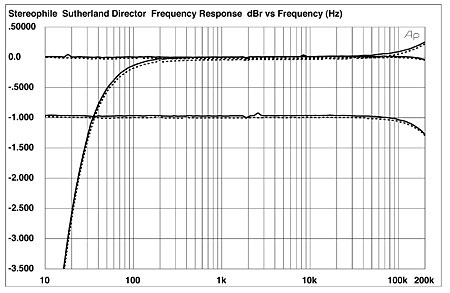
Fig.1 Sutherland Direct Line Stage, frequency response at 2.83V into (from top to bottom at 100kHz): 600 ohms, volume control at max (also bottom at 20Hz); 100k ohms, volume control at max; 100k ohms, volume control at unity gain (0.5dB/vertical div., right channel dashed).
Far from the Direct Line Stage's high frequencies measuring as rolled-off, as conjectured by BD, the preamp's ultrasonic bandwidth was very wide, though this was apparently somewhat dependent on both the volume-control setting and the load. With the control set to its maximum, the response into 100k ohms was flat to 200kHz, but tilted up slightly (+0.3dB at 200kHz) into the unrealistically low 600 ohm load (fig.1, top traces). With the control set to unity gain (fig.1, lower traces above 40Hz), the ultrasonic output is down 0.3dB at 200kHz. These differences will be inconsequential in practical use, but the Direct Line Stage's owner should be aware that this preamplifier will faithfully pass on to the power amplifier any ultrasonic noise present in the source signal—from an SACD player, for example—which might give unpredictable results in some systems.
Channel separation (ref. 3V output) was excellent at better than 100dB below 1kHz, though it decreased with increasing frequency to approximately 75dB at 20kHz, due to the usual capacitive coupling between channels (fig.2). DC offset on the outputs was less than 0.5mV, and the signal/noise ratio (in Direct mode, ref.1V output with the volume control at its maximum but the input shorted) was a superb 94dB (unweighted, wideband figure), improving to 104dB when A-weighted. Switching the inputs to Attn will drop the preamp's already low noise floor even lower.
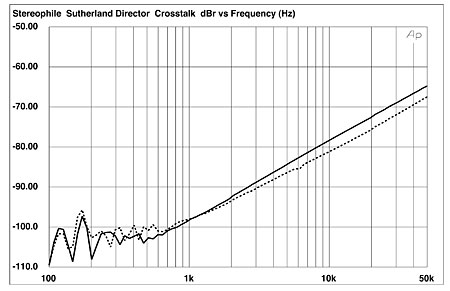
Fig.2 Sutherland Direct Line Stage, channel separation (10dB/vertical div.).
Fig.3 plots the percentage of THD+noise in the Direct Line Stage's output against voltage into both 100k ohms and 600 ohms. The downward slope of the traces in this graph below 2V or so suggests that the measured percentage is dominated by noise; ie, any distortion spuriae are buried in that noise. Only above that level—typically, the maximum voltage required from the Direct Line Stage to drive the partnering amplifier into clipping—does the true distortion start to rise, which is sensible gain-architecture design. The preamp itself clips at 8.1V into 100k ohms and at 5.6V into 600 ohms, both figures well above the maximum required in real-life systems.
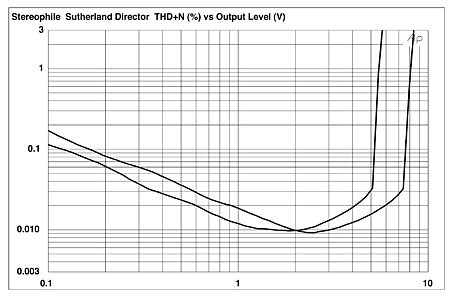
Fig.3 Sutherland Direct Line Stage, distortion (%)vs 1kHz output voltage into (from bottom to top at 3V): 100k, 600 ohms.
I plotted the THD+N percentage against frequency at a 2V output level, where the THD is at about the level of the background noise (fig.4). The bottom pair of traces was taken into 100k ohms, the top into 600 ohms. There is very little difference, though the THD percentage starts to rise a little above 10kHz into both very high and very low impedances. The Direct Line Stage is undoubtedly a very linear device. Fig.5 shows the FFT-derived spectrum of its output voltage driving a 1kHz tone at 1V into 8k ohms, about the lowest load the preamp will see in normal use. The measured THD (true sum of the harmonics) is just 0.0033%, and the subjectively benign second harmonic is the highest in level, at –90dB. The second harmonic remains the highest in level into both higher and lower impedances, suggesting that the Sutherland's linearity won't be much affected by the load it is asked to drive.
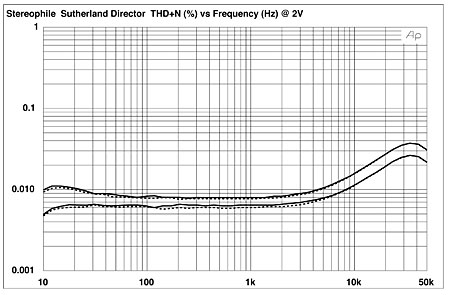
Fig.4 Sutherland Direct Line Stage, THD+N (%)vs frequency at 2V into (from bottom to top): 100k, 600 ohms.
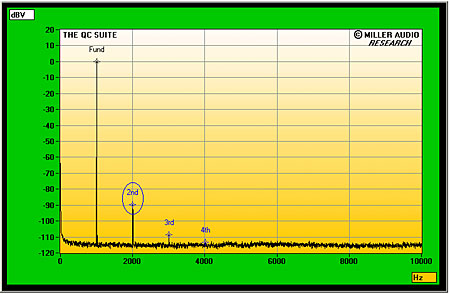
Fig.5 Sutherland Direct Line Stage, spectrum of 1kHz sinewave, DC–1kHz, at 1V into 8k ohms (linear frequency scale).
Finally, intermodulation distortion is also low in level. The difference component resulting from the preamp being asked to drive an equal mix of 19kHz and 20kHz tones with a combined level of 1V into 8k ohms lies at a vanishingly low –106dB (0.0005%), though the higher-order components at 18khz and 21kHz are a little higher in level (fig.6). This graph, by the way was taken with the Direct Line Stage's volume control set to give 10dB of attenuation. With it set to the maximum volume in Direct mode, there was slight noise-floor modulation apparent (not shown), but this is a condition that will never be found in practical use.
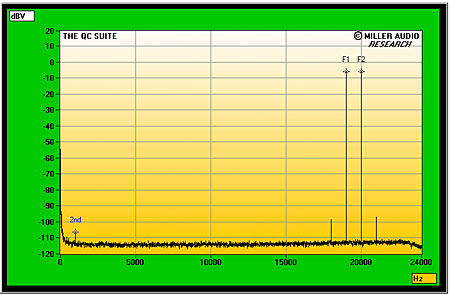
Fig.6 Sutherland Direct Line Stage, HF intermodulation spectrum, DC–24kHz, 19+20kHz at 1V peak into 8k ohms (linear frequency scale).
As I have come to expect from a Ron Sutherland design, the Direct Line Stage offers excellent audio engineering coupled with an imaginative and intuitive user interface.—John Atkinson
- Log in or register to post comments




































